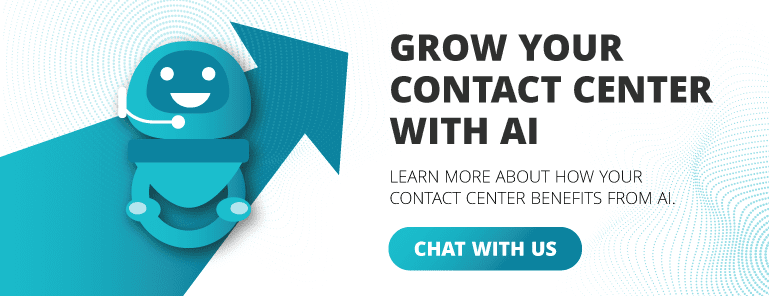Have you ever thought about what the future will look like? If I had things my way, I would have a robot do the tedious tasks around my house. Seriously — I’m on the lookout for a robot to wash my dishes and make my bed every morning.
We aren’t there yet, but we’re not far off.
According to the World Economic Forum, nearly 40% of the time spent on chores could be automated within a decade. While we’re still training robots to fold laundry, AI and automation are transforming how we work across every industry — especially in contact centers.
Research from Forrester found that 46% of contact center decision-makers already use robotic process automation (RPA). What’s more, some 74.5% of companies plan to adopt generative AI for customer service activities.
It’s time to add the power and efficiency of AI and automation to your contact center.
Discover how AI can improve your customer service in our blog.
What is Contact Center AI and Automation?
Contact center AI and automation use artificial intelligence technologies and automated processes to enhance efficiency, effectiveness, and customer experience in contact centers. Using tools like RPA, chatbots, intelligent routing, and advanced analytics, contact centers see a wealth of benefits, including:
- Increased productivity
- Reduced workloads
- Scalable operations
- Improved cost efficiency
- Higher customer satisfaction
- Increased agent satisfaction
Read on to see how you can use AI and automation to optimize your contact center.
How to Use AI and Automation to Optimize Your Contact Center
Add Virtual Agents to Improve Wait Times and Self-Service
No one likes waiting on hold. In fact, 60% of customers will only wait on hold for 60 seconds before they hang up. And nearly 50% say they would switch brands if they thought they could get better service elsewhere. AI can help you combat the long wait times that contribute to customer churn.
Powered by natural language processing (NLP) and machine learning (ML), chatbots and virtual agents allow you to instantly help customers at any hour of the day while providing human-like interactions. By adding chatbots and virtual agents, you free your human agents to focus on more complex and nuanced customer issues.
Intelligently Route Calls for Increased FCR
Salesforce found that 83% of customers want their issue resolved on the first call. That’s a high bar to reach if you rely on a traditional IVR system. Intelligent call routing enables customers to reach the best agent and department. When routing calls, AI technology accounts for the customer’s needs, each agent’s expertise, and agent availability. This ensures faster resolutions and higher customer satisfaction. Plus, it empowers agents to use their strengths in each interaction.
Read our blog to learn why contact center AI is worth the investment.
Speed Up Ops with Robotic Process Automation (RPA)
When they’re not helping customers, contact center agents handle a lot of tedious busy work. They enter data, fill out forms, organize files, process orders and payments, schedule appointments, and more. Over time, these repetitive tasks become time-consuming and boring. And when work gets mundane, agents are more likely to be disengaged, experience burnout, and make errors.
You can use AI-powered workflow automation and RPA tools to automate these tasks. This will speed up operations, reduce errors, and remove some of the less interesting work from your agents’ plates. With this busy work out of the way, agents can use their time to focus on more stimulating and meaningful work — like building relationships with customers.
Improve the Quality of Interactions with Speech and Text Analytics
Here’s a familiar scenario: You answer the phone, and immediately, a customer rants at you, listing all the issues they experienced with your product. Let me tell ya, stuttering out a panicked reply won’t de-escalate the situation.
With speech and text analytics, agents have the real-time support they need to handle these kinds of interactions. Here’s how they work:
- Speech and text analytics can track customer emotions, evaluate their history, and search relevant topics.
- Then, they offer real-time suggestions to help agents evaluate customer sentiment and gain insight into what to say next.
- With this feedback, agents have a pseudo-coach that helps them improve the quality of each interaction for better customer satisfaction.
Explore more ways to improve your operations and CX with automation in this blog.
5 Best Practices for Seamlessly Adding AI and Automation
Adding AI and automation to your contact center is a big feat that will, inevitably, upend your current processes and change how you work. So we’ve outlined a few best practices to make the transition as seamless as possible.
1. Align on the Why
The popular author and CX leader, Simon Sinek, says good leaders must “start with why” before making big decisions. For strategic change to be successful, you need a why behind it. Why are you making this change? Why are you pursuing this project? And why are you adding AI and automation? Set yourself up for success by aligning as a team on why this change is valuable.
Then, define clear goals, such as improving customer satisfaction, reducing operational costs, and enhancing agent productivity. A shared vision will help drive the initiative and secure buy-in from all stakeholders.
2. Identify Opportunities and Pain Points
Conduct a thorough assessment of your contact center operations to identify areas where AI and automation can have the most impact. This will help you know what you’re looking for as you build an RFI and evaluate which vendor meets your needs.
Look for repetitive tasks, bottlenecks, and pain points in the customer journey. Understanding these opportunities will help you prioritize the implementation and maximize ROI.
3. Invest in the Right Tech
Take time to research vendors and select technology that aligns with your specific needs and goals. Work closely with your IT team to look for solutions that integrate with your existing tech. Then, identify the features and capabilities you need to fix your opportunities and pain points.
Investing in the right tech from the start will save time, resources, and potential headaches down the line.
Need a place to start? Learn about our new AI solution, Go.AI.
4. Develop Skills for Adoption and Transformation
Don’t just throw new tech at your agents. Ensure your team has the skills they need to use the new technology. Provide comprehensive training on the new systems and processes and ask your vendor if they provide training, resources, and demos during implementation. Then, meet regularly as a team to shape your new systems and processes to fit your unique needs. Fostering continuous learning will empower your team to use AI and automation tools and drive meaningful results.
5. Measure and Measure Again
AI and automation will learn and improve over time, but only if you’re measuring it. Regularly track the impact of AI and automation on your contact center operations by evaluating key metrics like handle times, resolution times, and customer satisfaction. Consistently measuring can help you assess the success of the implementation and identify areas of further optimization.











